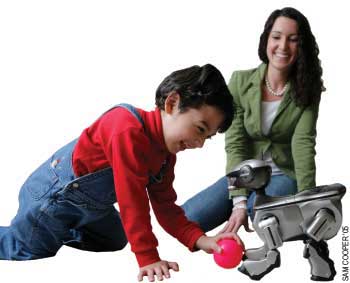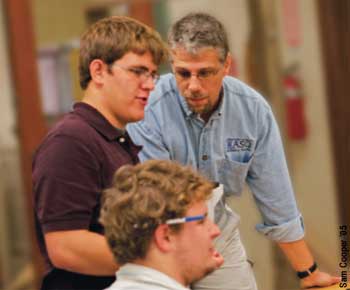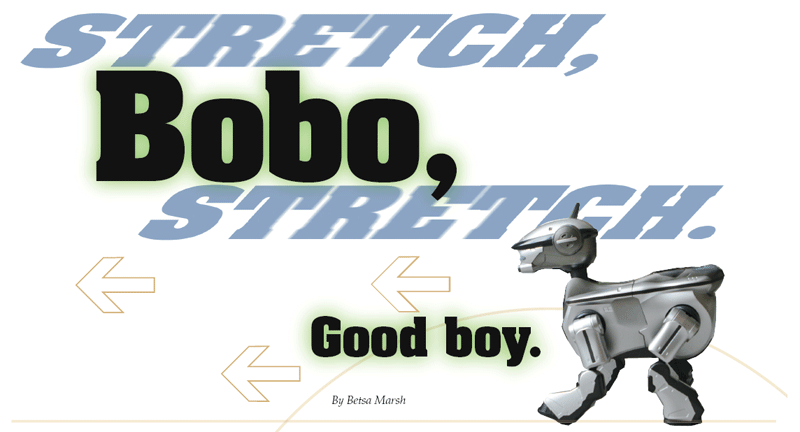|
The little dog in front of the class raises his front paw, and his preschool pals lift their arms in response. Down on his tummy, the dog cranes his neck and flings out his front legs in the airplane stretch, and the children mimic every move. It’s like Simon Says, without the Simon or the “says.” But given how much children love dogs, no one’s quibbling over details.
One facet of the choreography is especially fascinating to the researchers who ring the small elementary classroom. For this is no ordinary therapy dog, all wagging tail, chocolate eyes, and cuddly fur. This is Aibo, the metal mongrel dreamed up by the minds at Sony, all sensors, camera, and microphone.
Would the children in this session warm to the little robotic rover as a new exercise leader, assisted by the encouraging commands of physical therapist Amy Vollmer? Or would they be frightened of his sci-fi looks?
Not to worry. The children immediately name him Bobo and want to pummel him with pats.
“At first, it was difficult to keep their hands off the dog,” Vollmer says. “I thought a few children might be afraid, but they weren’t. The dog isn’t fuzzy, but the children acted as if it were an animal.”
Bingo! thought the Miami mechanical engineering students who’d programmed Aibo. This was more than they could have hoped for as they struggled with the complex robotic research in a yearlong senior capstone project.
Michael Bailey-Van Kuren, associate professor of mechanical and manufacturing engineering, had set the challenge to the 2005-06 seniors. Could Aibo be programmed as a valuable assistant to a human physical therapist working with developmentally delayed children?
Twenty seniors applied for the project, with four assigned to the team: Erin Gatta, Alicia Morris, Andrea Van Houten, and Aaron Morgenstein.
 For Morgenstein, it was the perfect melding of his passions: engineering and health care. He’d already volunteered a year in adult physical therapy at McCullough-Hyde Memorial Hospital in Oxford, Amy Vollmer’s hospital, and knew the kinds of movements patients were asked to imitate. He and his colleagues had the computer skills to learn Aibo’s new programming language, and they were eager to research the kinds of muscle-control problems that make it difficult for young patients to walk, run, jump, play ball, and ride a tricycle. For Morgenstein, it was the perfect melding of his passions: engineering and health care. He’d already volunteered a year in adult physical therapy at McCullough-Hyde Memorial Hospital in Oxford, Amy Vollmer’s hospital, and knew the kinds of movements patients were asked to imitate. He and his colleagues had the computer skills to learn Aibo’s new programming language, and they were eager to research the kinds of muscle-control problems that make it difficult for young patients to walk, run, jump, play ball, and ride a tricycle.
In the seniors’ research, they discovered that children respond better to robotic animals than to teddy bears, “almost believing the robot is living,” Morgenstein says.
Armed with information on cerebral palsy, the Miami team met with Vollmer. What movements would be most productive for the children? How could they program in fun, too, since so much of Vollmer’s therapy is meant to feel like play?
Also a physical therapist at Talawanda Schools, Vollmer is a veteran of Miami students’ engineering projects. She tried out an orthotic boot and a force-sensing glove to measure a patient’s limb strength, both developed by professor Bailey-Van Kuren as innovations to improve pediatric PT. When he suggested a robotic dog join her class at Marshall Elementary, she didn’t blink.
“It’s good for the preschoolers and wonderful for the students at Miami,” says Vollmer, who studied at Miami in 1988-90 before moving into physical therapy at Ohio State University. “Not only are they working on their engineering skills, but they also help others. I felt it was motivating for them.”
Bailey-Van Kuren had seen a demonstration of similar research at a conference: robots and therapists working with stroke patients. He thought of the Aibo dogs on the shelf at the School of Engineering and Applied Science and of the young PT patients he’d assisted. “I’m always looking for cross-links, to apply known technologies to new problems.”
After months of research and programming, the capstone students took Aibo to Vollmer’s class at Marshall. The Miami students filmed as Vollmer and Aibo — soon to be nicknamed Bobo — asked the preschoolers to walk, extend their arms, sit up tall, balance, and, most complex, do the airplane stretch.
As Vollmer introduced each posture with “The dog wants you to do this,’’ the children did their best to match Bobo’s moves. After the robot wrapped up with a victory dance to his own keyboard music, the children tossed Aibo’s pink ball for him to chase and bat.
“The children were very successful,” Vollmer says. “To the best of their ability, they did better than they did imitating me. The dog would be a luxury, as much as children love animals and respond to therapy dogs.”
 Reviewing the video, the seniors realized Aibo’s head didn’t go down and up for the airplane stretch, a movement that helps cerebral palsy patients strengthen chronically weak neck muscles. They reprogrammed him for his return visit, which included Bobo initiates and newcomers. Reviewing the video, the seniors realized Aibo’s head didn’t go down and up for the airplane stretch, a movement that helps cerebral palsy patients strengthen chronically weak neck muscles. They reprogrammed him for his return visit, which included Bobo initiates and newcomers.
Would the children from the first session dismiss the dog as old news? “For this small pilot, the motivation was maintained,” Bailey-Van Kuren says.
One of the problems inherent in Bobo is, of course, his status as a quadruped. “When the dog wanted them to stand on one foot, the kids would get down on all fours and put one leg or arm up,” Vollmer says. In one video clip, Bobo loses his balance and falls on his side; one of the little boys mimics him perfectly, flopping onto the exercise mat in giggles.
For future capstone robotic projects, Bailey-Van Kuren is already mulling over a solution to the dog’s limitations. Can you say biped? And he’s exploring robots for home use, expanding a child’s PT beyond the session with his therapist.
To Morgenstein, who enters the University of Kentucky medical school this fall, robotics is “the future of medicine. They will one day take over in the operating room, and if you don’t understand them, you won’t be successful.”
Even with his engineering degree, PT voluntarism, and undergrad pre-med fellowships, Morgenstein discovered that the Aibo project sparked the most interest during his med school interviews.
“It really helped me get into med school, although that’s not why I did it in the first place. It was the best opportunity to show my interest in both engineering and medicine. I’m very proud of the project.”
The capstone went beyond the hard science of engineering and the hard metal of Aibo’s body.
“The children were smiling, giggling, and following along,” Morgenstein recalls of the preschoolers. “They were able to interact with the dog more than I ever thought possible.
“When one child had to leave the room early, he said, ‘I love you, Bobo!’ I really wanted us to get that on tape.”
A frequent writer for Miamian, Betsa Marsh received plenty of input on this piece from her 2-year-old “puppies,” Ike and Selkie.
 Back to the Miamian Magazine Summer 2007 Web page Back to the Miamian Magazine Summer 2007 Web page
|

 For Morgenstein, it was the perfect melding of his passions: engineering and health care. He’d already volunteered a year in adult physical therapy at McCullough-Hyde Memorial Hospital in Oxford, Amy Vollmer’s hospital, and knew the kinds of movements patients were asked to imitate. He and his colleagues had the computer skills to learn Aibo’s new programming language, and they were eager to research the kinds of muscle-control problems that make it difficult for young patients to walk, run, jump, play ball, and ride a tricycle.
For Morgenstein, it was the perfect melding of his passions: engineering and health care. He’d already volunteered a year in adult physical therapy at McCullough-Hyde Memorial Hospital in Oxford, Amy Vollmer’s hospital, and knew the kinds of movements patients were asked to imitate. He and his colleagues had the computer skills to learn Aibo’s new programming language, and they were eager to research the kinds of muscle-control problems that make it difficult for young patients to walk, run, jump, play ball, and ride a tricycle. Reviewing the video, the seniors realized Aibo’s head didn’t go down and up for the airplane stretch, a movement that helps cerebral palsy patients strengthen chronically weak neck muscles. They reprogrammed him for his return visit, which included Bobo initiates and newcomers.
Reviewing the video, the seniors realized Aibo’s head didn’t go down and up for the airplane stretch, a movement that helps cerebral palsy patients strengthen chronically weak neck muscles. They reprogrammed him for his return visit, which included Bobo initiates and newcomers.